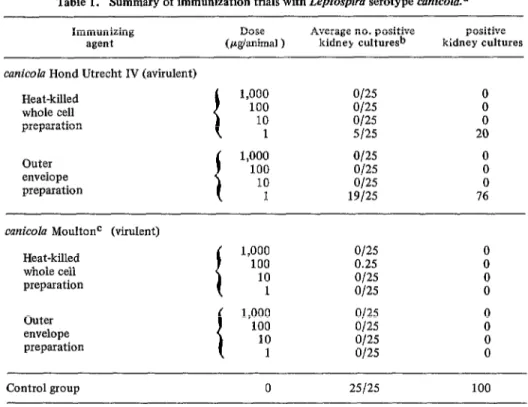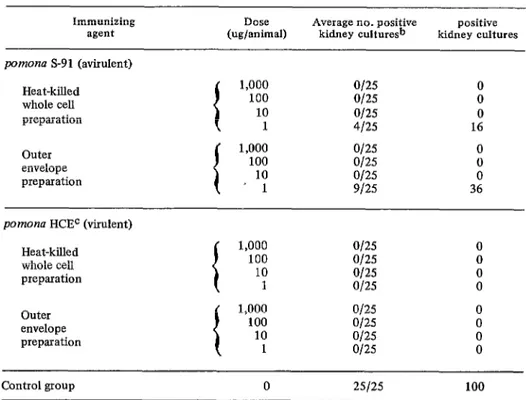IMMUNIZATION
AGAINST
LEPTOSPIROSIS:
VACCINE TRIALS WITH
HEAT-KILLED
WHOLE CELL AND OUTER ENVELOPE ANTIGENS
IN HAMSTERS1
J. A. Zeigler, R. H. Jones, and K. Kubicaz
Two leptosfiiral antigen preparations were evaluated as vaccines. Heated whole cell suspensions proved very effective in protecting hamsters against experimental leptospirosis.
Introduction
Leptospirosis is considered to be the most important zoonosis in Barbados. Of the 88 clinical cases reported in 1970 and 1971, approximately 30 per cent were terminal (I). Subsequent serologic studies revealed that a very high percentage of the cattle surveyed had significant serum agglutination levels for Leptospinz of the Autumnalis serogroup (2). Cultures of kidneys removed from trapped wild rodents yielded Leptos#ira strains of the serogroups Icterohaemorrhagiae, Ballum, Canicola, and Autumnalis-this last in- cluding a strain serotyped as fort-bragg (1, 4 3).
The investigation reported below3 was ini- tiated in response to the leptospirosis problem in Barbados. It was necessary to first develop an effective vaccine prototype using known model strains prior to evaluating freshly isolated strains from Barbados.
IAlso appearing in Be2 Of Sanit Panam 81 (3), 1976. 2AlI of the Medical Research Institute, Florida Institute of Technology, Melbourne, Florida, USA.
3Research supported by Pan American Health Organization Project AMRO-3139 and The John A. Hartford Foundation Grant No. 74346. New York, New York.
Materials and Methods
Outer envelope preparations of Leptospira interrogans serotypes canicola Moulton, cani- cola Hond Utrecht IV, Pomona S-91, and Pomona HCE were obtained by the method of Zeigler and Van Eseltine (4). Briefly, the outer envelopewas removed from the cell by osmotic shock, purified by isopycnic gradient centrifugation, and lyophilized. Serotypes canicola Moulton and Pomona HCE are pathogenic for hamsters, whereas cunicolu Hond Utrecht IV and pomona S-91 are avirulent.
All serotypes were maintained in bovine albumin polysorbate 80 semisolid medium (5) and subcultured at 30-day intervals. Liquid cultures were prepared by inoculating fresh semisolid medium and then transferring to liquid medium after growth at 29°C for five to seven days.
Zeigler - IMMUNIZATION AGAINST LEPTOSPIROSIS
127
cell pellet in 50 ml of sterile 0.85% saline, and heating at 56°C for 30 minutes followed by lyophilization. For all the serotypes men- tioned heat-killed bacterin and outer en- velope preparations were made using in each case cells grown on the same batch of medium. Serial dilutions of the heat-killed whole cell bacterins were prepared in the same manner as the outer envelope materials.
In the vaccine trials the hamsters used were 40-gram weanling females separated into five groups of five animals each. The groups were inoculated intraperitoneally with 1,000, 100, 10, or 1 Z.q per animal of either the outer envelope or heat-killed whole cell prepara- tion. Controls were inoculated with sterile 0.85% saline.
At 14 days after inoculation the immunized hamsters and the uninoculated controls were challenged intraperitoneally with approxi- mately 2 X 10s cells/animal of the respective serotype. The challenged animals were ob- served for 21 days. The surviving animals were killed and their kidneys cultured. The kidney tissues were ground with a mortar and pestle in a mix of sterile sand in sterile phos- phate buffer. Serial dilutions were inoculated into four tubes of bovine albumin polysorbate 80 semisolid medium. The cultures were incubated at 29% and examined weekly for 10 weeks. The presence of a “Dinger’s ring” in the culture tube and leptospiral cells, as observed by dark-field microscopy, was considered to indicate a positive culture.
Confirmation of leptospiral serotype was determined by the microagglutination test, as described by Galton et al. (6).
All cell. counts were determined by dark-field microscopy using a Petroff-Hausser counting chamber.
Results
The hamsters immunized with the outer envelope preparation derived from canicoZu Hond Utrecht IV were challenged with 2 X
lo6 cells/animal of virulent canicolu Moulton (Table 1). Immunogen concentrations of 1,000, 100, and 10 pg/ml protected vacci- nates against both death and renal infection. At the 1 pg/ml concentration, however, renal infection (but not death) was observed; 76 per cent of the kidney cultures were positive (19/25) at this concentration, whereas none were (O/25) at the higher levels. The heat-killed whole-celi bacterin prepared from avirulent canicolu was a more potent immu- nogen at the same dosage levels than the outer envelope preparations; only 20 per cent of the kidney cultures were positive (5/25) at the 1 wg/ml level.
Immunization with outer envelope and heat-killed whole cell preparations of virulent cunicola Moulton was very effective, resulting in no deaths or positive kidney cultures at the end of the obvervation period.
The results from the experiments with virulent @omona HCE and avirulent pomona S-91 (Table 2) were similar to those obtained with the avirulent and virulent canicolu strains. None of the animals immunized with virulent pomona HCE (either the outer en- velope or heat-killed whole cell preparations) and challenged with the homologous organ- ism gave positive cultures. On the other hand, those receiving pomona S-91 heat-killed whole cell bacterin produced 16 per cent positive kidney cultures (4/25) at the 1 pglml concentration, while those receiving pomona S-91 outer envelope produced 36 per cent positive cultures (9/25) at the same concen- tration.
Discussion
128
PAHO BULLETIN * Vol. X, No. 2, 1976Table 1. Summary of immunization trials with Lepfospiru serotype cunicolu.a
Immunizing
agent Dose
Average no. positive
(/.qkmimal ) kidney culture& kidney cultures positive cunicolu Hond Utrecht IV (avirulent)
Heat-killed whole cell preparation
Outer envelope preparation
t
1,000 100 10 1
i
1,000 100 10 1
O/25 O/25 O/25 5125 o/25 o/25 O/25 19125
0 0 0 20 0 0 0 76
mnicolu MoultonC (virulent) Heat-killed
whole cell preparation
Outer envelope preparation
o/25 0
0.25 0
O/25 0
O/25 0
1,000 O/25 0
100 o/25 0
10 1 O/25 O/25 x
Control group 0 25125 100
aAt 14 days after inoculation the immunized hamsters and the diluent-inoculated controls were challenged intraperitoneally with 2 x 106 cells/animal of the virulent serotype.
bAfter 20 days the surviving animals were sacrificed and their kidneys cultured. cMean death time for cunicolu Moulton was 4.3 days for 2 x 106 cells IP.
Although all the preparations protected Bey et al. (9), using probit analysis, against death, renal infection was observed at recently found a lower minimum effective the lowest dosage level with those derived protecting dose with an outer envelope from avirulent organisms. It is possible that bacterin tested in hamsters prepared by the loss of virulence may be accompanied by a method of Auran et al. (IO) than that tested corresponding reduction in antigenicity. At in the studies reported above (0.72 pg/animal the lowest concentrations tested, the heat- as opposed to 1 fig/animal). Glosser et al. killed whole cell bacterins appeared to be (II), using the outer envelope preparation as more effective in preventing renal infection described by Auran et al. (IO), found that a than the outer envelope preparations. A dosage level of 11.5 @g/animal protected possible explanation for the latter is that there against renal infection in hamsters. The may be varying amounts of different antigens antigens described by Bey et al. (9) were outer in the heat-killed whole cell bacterins, which envelope and whole cell, the outer en- would not be the case with the relatively pure, veloped being chemically dissociated and probably type-specific antigen in the outer reaggregated, while the whole cell prepara-
envelope preparations. Recent findings by tion was made from lyophilized live cells.
Zeider - IMMUNIZATION AGAINST LEPTOSPIROSIS
129
Table 2. Summary of immunization trials with Leptospiro serotype pornon~.~ Immunizing
agent (ug/animal) Dose Average no. positive kidney culture& kidney cultures positive pomono S-91 (avirulent)
Heat-killed whole cell preparation
Outer envelope preparation
a/25 0
o/25 0
o/25 0
4125 16
o/25 0
O/25 0
O/25 0
9125 36
pomona HCEC (virulent)
Control group 0 25125 100
=At 14 days after inoculation the immunized hamsters and the diluent-inoculated controls were challenged intraperitoneally with 2 x 106 cells/animal of the virulent serotype.
bAfter 20 days the surviving animals were sacrificed and their kidneys cultured. CMean death time for pomonu HCE was 4.5 days for 2 x 106 IP.
On the contrary, in the experiments above the heat-killed whole cell bacterins proved at least as effective as the physically derived outer envelope preparations, or more so. By far, heating whole cells is the easiest, most economical method of preparing a bacterin; moreover, the results indicate that this would be the preparation of choice. These findings are consistent with those recently obtained by Ellinghausen and Painter (personal commu- nication)-namely, that heated whole cell antigens are effective protecting immu- nogens .
The data presented herein are the results of
immunization studies of whole cell and cell fraction bacterins prepared from sero- types known to be pathogenic for man and animals. The minimum dosage level required
to protect against death and renal infection, and the duration of protection, are currently being investigated. Studies are also underway using heat-killed whole cell bacterins pre- pared from isolants received from Barbados.
SUMMARY
Heat-killed whole cell and outer envelope an-
tigens prepared from homologous virulent and
avirulent strains of Le$tos$ira serotypes canicoZ42 and pomona were evaluated for protecting hamsters against experimental leptospirosis. The heat-killed bacterins proved at least as effective as the outer envelope antigens, or more so, in providing protection against death and infection, and they are easier and more economical to
130
PAHO BULLETIN . Vol. X, No. 2, 1976REFERJZNCES
(I) Jones, C. J, Preliminary report on the isolation of 12 Leptospira serotypes in Barbados.
West Indian Med J 65:65-68, 1974.
(2) Myers, D. Leptospirosis Unit Summary Report, Project LEP 3; Isolation of serotype fort bragg in Barbados and its possible association to leptospirosis of cattle and man Pan American Zoonoses Center, Scientific Advisory Committee Report. November 1974.
(3) Myers, D. M.. and C. J. Jones. Leptospira fort-bragg isolated from a rat in Barbados. Bull
PAHO 9:207-211, 1975.
(4) Zeigler, J. A., and W. P. Van Eseltine. Isolation and characterization of outer envelope of Leptosfiira gomona. Can J Microbial 21:1102- 1112, 1975.
(5) Ellinghausen, H. C., Jr., and W. G. Mc- Cullough. Nutrition of Lefitospira Pomona and growth of 13 other serotypes: A serum-free medium employing oleic-albumin complex. Am J
Vet Res 26:39-44, 1965.
(6) Galton, M. M., C. R. Suzler, C. A. Santa Rosa, and M. D. Fields. Applications of a micro-
technique to the agglutination test for leptospirosis antibodies.] A@@ Microbial 13:81-85, 1965.
(7) Kasai, I., and R. Yanagawa. Studies on the antigenic determinant group of the type-specific antigen of Leptospira canicola. Z Bakt Parasit Infekt Hyg ABT I Orig 228:533-541, 1974.
(8) Palit, A., R. C. Hamilton, and J. Gulasek- haram. Further studies on leptospiral genus- specific antigen: Its ultra-structure and immuno- chemistry. J Gen Microbial 82:223-236, 1974.
(9) Bey, R. F., N. E. Auran, andR. C. Johnson. Immunogenicity of whole-cell and outer envelope leptospiral vaccines in hamsters. Infect Immun 10(5):1501-1506, 1974.
(10) Auran, N. E., R. C. Johnson, and D. M. Ritzi. Isolation of the outer sheath of LeptospiTa and its immunogenic properties in hamsters. Infect Immun 5:968-975, 1972.

